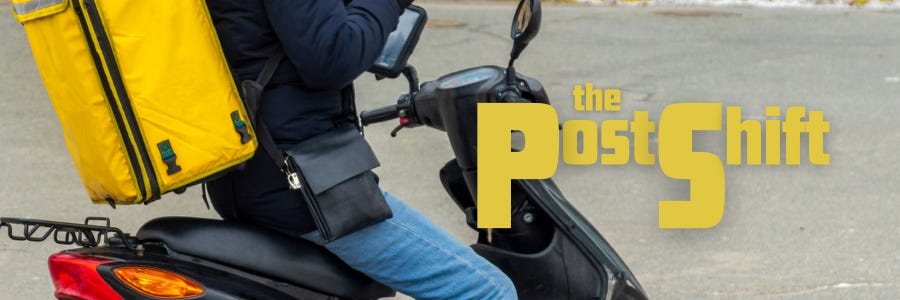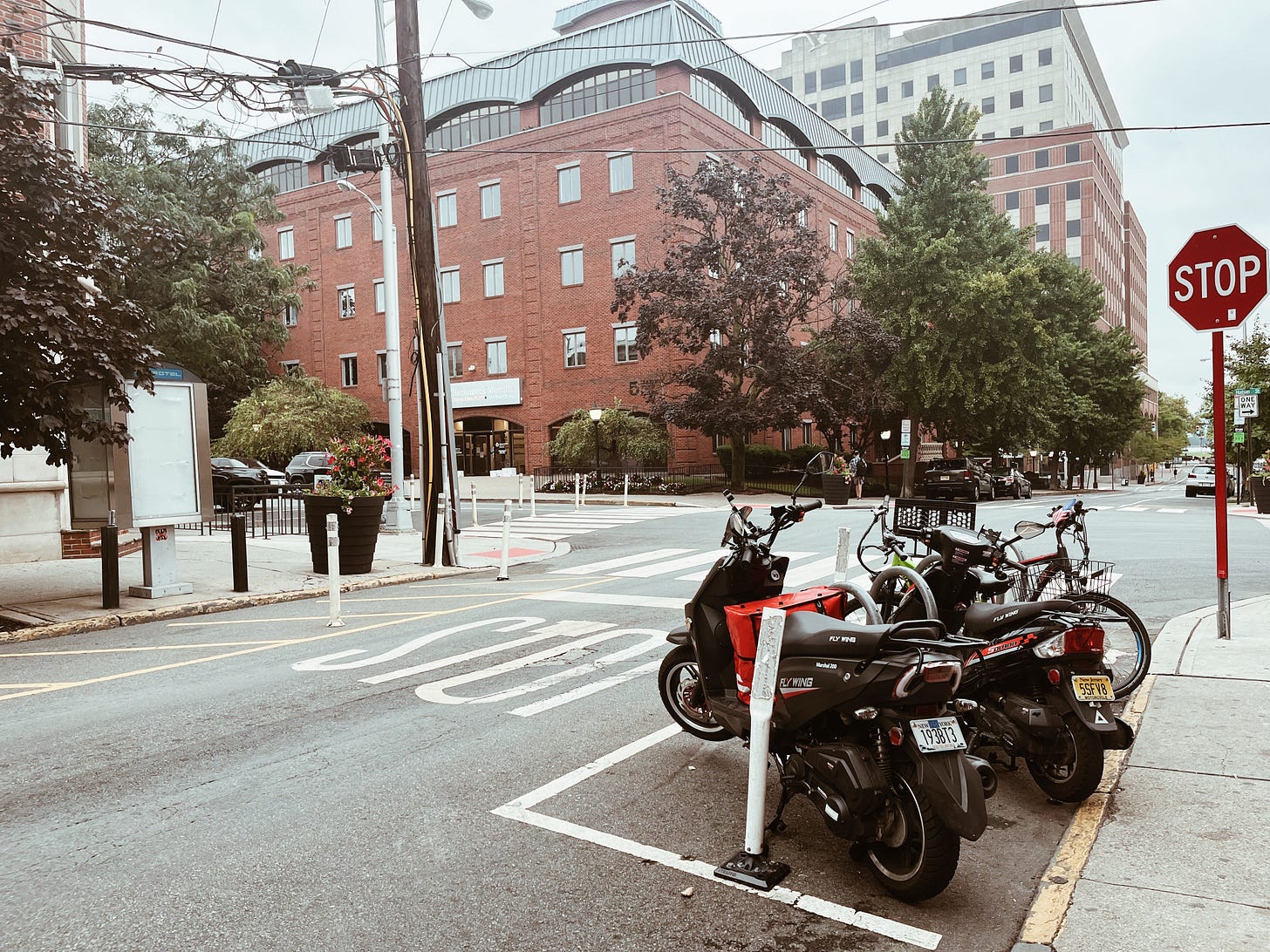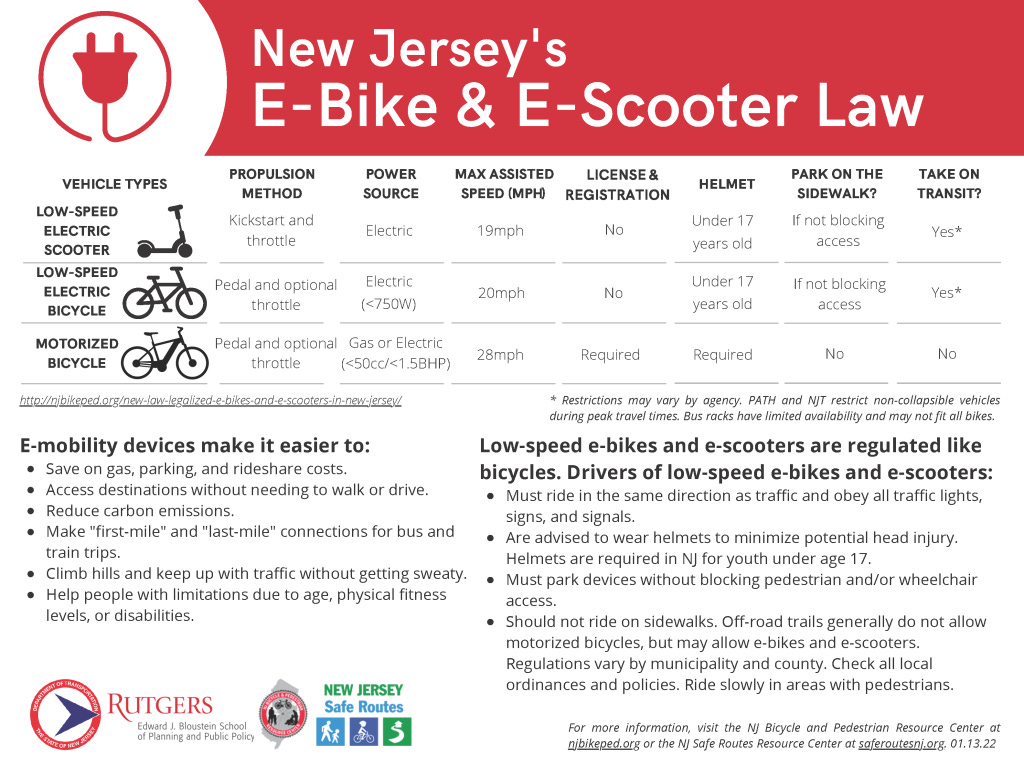Everything you need to know about e-bike deliveries in Jersey City and Hoboken.
Laws, legislation, and dignity for everyone who orders or delivers food.
📦 Special delivery, all. 📦
I’m here with a piping-hot story on something relevant to my local community, but occurring elsewhere across the country — delivery apps and their drivers.
If you work in restaurants, you probably have an opinion about delivery drivers. And if you order delivery for dinner, you’ve probably got a lot of questions.
I’m reporting from Jersey City / Hoboken (where I currently work and live), two communities who have recently seen a massive shift in to-go delivery food, thanks to a fast-growing post-pandemic metro landscape.
No one can deny the convenience of these apps, and as OpenTable put it, “third-party delivery isn’t going away.”
If that’s the case, it’s time to take a hard look at how to better live with today’s service environment, with a special focus today on e-bikes and other ‘micromobility vehicles.’
If you’re a local reader in the Hudson County area, welcome! I’m Erin, but you can call me ET. I live, cook, report, and make coffee in the neighborhood. Please get lively in the comments section, because this topic needs more voices added to the conversation. And, more importantly, it needs active people getting involved.
Let’s dive in.
It’s a bright, mid-summer afternoon and pedestrians are walking down Hoboken’s Washington Street, lattes and shopping bags in hand. Suddenly, seemingly out of thin air, an e-bike whizzes past, dipping from the sidewalk to the street and back again, manned by an all-too-casual driver. Nannies with strollers shoot dirty looks their direction, pedestrians take a startled step back. These deliveristas, once a sight more likely seen across the river in NYC, now run the streets of Hoboken and Jersey City.
You may have observed herds gathered in front of Mamoun’s or cutting swiftly and precariously through traffic across town. Perhaps you’ve turned to Reddit to express your frustration, or taken it upon yourself to shout expletives into their retreating trails of dust. You may have even noticed a rise in stories like this one, where delivery drivers have been caught groping strangers in public and whizzing away.
Other than the persistent frustration of leaning on your car horn as scooters dodge through traffic — what do you really know about the delivery e-bike situation?
Don’t worry, I’m here to answer all your burning questions.
What are the laws around e-bike deliveries in Hoboken and JC?
Let’s start with the basics and get the rules out of the way.
Hoboken.
If you’re a delivery driver in Hoboken, you now officially have to be registered with the city. It’s going to cost you $5, and you’ll need fill out an application, take a traffic test, and get a bright neon vest. And yes, once you have the vest, you’ve got to wear it (and keep the license on you) or you’ll catch a $50 fine. After 3 fines, you’ll end up reported to your delivery app and your license will be revoked. Your license is good for two years before needing a re-up.
You can find your pertinent rules and regulations here:
Jersey City.
Jersey City’s brand new ordinance, which went into effect last weekend (8/1/24), covers payment and tipping for delivery workers, restaurant involvement in third-party apps, and safety measures for delivery drivers.
While there aren’t specifics yet delegated to licenses and vests the way that Hoboken has implemented, the new legislation will require Jersey City restaurants and delivery companies that employ delivery workers to offer safety courses. These courses — not yet complete — are currently in development by the city.
Delivery drivers will have to earn a safety certificate that they will be required to carry on their person during deliveries.
Stay tuned in JC, these ordinances are taking shape quickly. This story will be updated continuously to reflect the changes.
Are these laws and ordinances actually effective?
Since they rolled out on June 1 of 2024, we’ve yet to see. However, it does pose some interesting questions and concerns, many of which were raised when the ordinance was still being debated.
In place of a definitive answer, I have a few community responses. Please share your thoughts in the comments section as well.
“It’s a complicated and challenging issue to address because it deals with a population of delivery workers that tend to be people who are potentially undocumented, and come from overburdened communities already,” said Chris Adair in an interview with HobokenGirl back in February.
“There’s an element here where we are unfairly targeting people who are already disenfranchised, who may be afraid to walk into City Hall.”
She went on to say that many drivers may instead choose to risk a fine or simply not work in Hoboken anymore.
I got in contact with a full-time delivery driver in the area, who has been actively involved in the new legislative rollout, as well as helping deliveristas adapt on the streets. (He requested to remain anonymous, so I’ll refer to him as AMC or amcourier in this and future pieces. You can find his stance and activism on X.)
His response to the rollout:
“Hoboken wants a foundation to build on for safer streets. Residents are fortunate to have someone like [City Councilman] Paul [Presinzano] on their side. The man has grit. So much back and forth politically about getting around the e-bike problem and he jammed a possible solution. I’m sure he’s got more tricks up his sleeve… I mean, the man did deliveries himself!”
He adds that the system is not perfect, however, saying, “I signed up because I want the best for Hoboken, and if they vote that this is a viable solution, I’m on their side. Apps, on the other hand, did nothing to bring awareness to drivers about the vest after it passed. My stance has always been —and still is— enforce the law and work with your police department.”
Who are your deliveristas, actually?
If you’ve ordered delivery food at all in the last few years, you’ve encountered a deliverista. Yes, deliverista is the is the technical term.
These deliveristas run the gambit from full-time delivery drivers to part-time gig workers, and they’re all a part of the larger gig economy. You’re paying a price for all that convenience — and so are your drivers.
A significant immigration component is baked into the system, thanks to its low barrier to entry and ability to (illegally) provide instant work while bypassing documentation.
New migrants filing asylum applications are required to wait a full 180 days before becoming eligible to work, a barrier easily overcome by gaming the delivery app system.
Asylum seekers looking to bypass the wait time can easily pay an active account holder a fee to “rent” their account, getting them onto the streets and into the workforce immediately. It’s estimated the sweeping shadow army of delivery drivers currently spans over 65,000 workers in New York City.
As my aforementioned source here in Hoboken told me recently, “There’s just about no barrier to an account other than purchasing a vehicle. Sign up is easy. Getting an account on Facebook marketplace is also easy if you’re undocumented, or a felon.”
It’s worth noting that Hoboken, as a sanctuary city, prides itself on an open-armed policy that “welcomes all who are ready, willing, and able to contribute to our great city.”
As you can see, this is a nuanced and developing topic. We’ll get more into that in a later exploration.
How much money do these drivers really make?
Or as one citizen put it, “Is the delivery demand in Hoboken really that high to support all the delivery riders loitering on Washington street?”
Delivery apps send drivers out by radius, meaning a lot of those drivers you see chillin’ on the sidewalk are waiting to get matched to deliveries in the nearby vicinity. The fleet of bikes you see in front of Artichoke Basile’s is just their starting point.
Business is less lucrative now than it used to be, thanks to the growing delivery force, but drivers can make anywhere from $20-$35 an hour depending on the day, weather, and demand.
However, deliveristas that rent their bikes and/or accounts are paying significant fees, as well as the costs to store, repair, and maintain their bikes. They’re also all 1099 independent contractors, which means they’re responsible for their own taxes and insurance — as well as coverage for accidents and injury to themselves or their bikes.
You do the math.
How legal are the e-bikes, mopeds, and scooters?
In both cities, micromobility transportation is more than legal, it’s encouraged — provided you’re following the law. These laws are part of the new safety courses in place in both Jersey City and Hoboken, and will be required knowledge for all deliveristas.
You can find the state’s laws around e-bikes and scooters at this link:
In a nutshell: if you ride in the correct direction, stay off the sidewalk, and and follow traffic laws, you’re operating within the rules.
To be clear, these laws pertain to e-bikes and e-scooters, not mopeds. Mopeds don’t belong in the bike lane, they belong on the road with traffic.
Who’s responsibility is it to take care of gig workers like deliveristas?
Everyone has to eat, and that makes it the responsibility of just about everyone.
Delivery apps like UberEats, Doordash, Postmates, and Seamless are struggling to adapt to changing national laws around their services. Take a look at this informative piece on where that stands in places like Florida, Texas, and NYC.
Individual lawmakers are doing their best to care for restaurants, delivery drivers, and customers in their communities… a brave new world for a sector of restaurants that isn’t going anywhere. The onus is largely on the apps that make the job possible to keep an eye on the safety of their delivery force, period.
Restaurants (particularly in dense metro areas like NYC and its suburbs) have been left with the option to either participate in online delivery or lose out on major sales. Adapting to this new economy can be rough — where should deliveristas park the bikes? How can they avoid the disruption of regular service? How can a restaurant guarantee the quality of the food when it gets to the customer? And all of this while a driver is impatiently waving a phone in your face, demanding updates on their order — because to wait is to lose out on precious delivery time, and therefore, more gigs.
Don’t worry, I’ve got a deep-dive on restaurants coming down the pipeline shortly covering the tricky new intersection of restaurants and delivery. (If you have an opinion on this, industry readers, email me please!)
Customers already understand pretty well the realities of ordering delivery. If you count yourself a decent citizen, you leave an appropriate tip. If you can afford to leave more, not only will your delivery driver be stoked, you’ll probably get your food faster.
Communities. Even if you personally never order from delivery apps, the odds that you’ll run into a deliverista are very high. They’re waiting in line at your local cafe or pulling up beside you at a stoplight. Regardless of whether you actually use the apps, their impact is impossible to ignore on communities, and that makes them a local responsibility.
In a way, this is a trick question. No matter how they got here, delivery apps and delivery drivers aren’t going anywhere, which means it’s on all of our shoulders to make this new delivery world a better place.
Blaming the apps, the drivers, or the customers who order from these apps does nothing to make the problem go away. We’re all active participants here in the hybridized, convenient world of 2024 infrastructure. If you participate in the system — in any way — you have a responsibility to not be an asshole.
In that spirit…
What’s the best way to treat your delivery drivers?
If you’re a restaurant owner. It’s not just a kindness — in Jersey City, it’s now part of legislation to allow delivery drivers to use the restroom. Let ‘em pee, folks. Give these workers a little dignity. Unlike any other job, there is no break room on the road.
That’s the tip of the iceberg, of course. Each restaurant has its own space and service constraints to deal with. However, treating delivery drivers with the same hospitality you’d treat a quality customer guarantees a smoother, less resentful service, and probably garners you some good karma.
If you’re ordering food. Tip well!
As my anonymous delivery driver friend put it, “People don’t tip. So I wanna make this clear for everyone. Folks, if you order food, it doesn’t matter how many fees you’ve paid, and you don’t tip, the starting pay for us is $2. Doesn’t matter how far you live. It’s 2 bones. 2 beans. Those orders, your boy declines.”
He continues, “I know the follow up argument is, well, I should take that up with Uber or Doordash. If they paid me what you’re supposed to tip, this service would go out of business and most likely many restaurants with it. I’d much rather people take the time, consider the efforts in getting your food delivered to your door, tip, as if they’d tip a waiter, and go about your day. As much as I like Doordash coin or Uber coin, the [customer] appreciation goes much further.”
I’m saying it here first, for the record: delivery is the new front of house. More to come on this later.
If you’re driving in traffic. New Jersey has one of the highest rates of cyclist injury in the nation, so it should go without saying: treat riders with respect and keep your eyes open for them.
Until the city improves the bike lane situation, share the road. It’s actually the law, and you can read more about that here:
A quote from NJ’s Bicycle and Pedestrian Resource Center:
Is it really that big of a deal for a driver to squeeze by someone sharing the road? Yes! Fatalities are on the rise. Every day, people experience risky passes that leave no margin for error, sometimes with fatal consequences.
Drivers should approach vulnerable users of all kinds with due caution and pass safely, regardless of whether they ‘should’ be in the road or not.
If e-bike deliveristas have to take a test to share the road, it probably benefits drivers to refresh their memory on local bike laws as well.
How should your delivery drivers treat you?
This is quite literally a two-way street, and these are service apps, after all. Delivery drivers should treat customers with respect, which means taking care to deliver the order in good condition.
This includes treating the restaurants politely and patiently and taking care to deliver the food they worked so hard to make in a temperature-controlled manner — that means hot food should stay hot, and cold food should arrive cold, or as close to it as you can get. Delivery drivers are unofficial liaisons of the restaurant.
Deliveristas should communicate clearly and effectively with their customers, too. I wouldn’t go so far as to suggest ‘service with a smile,’ but… don’t be a dick.
And if your delivery order sucks?
Another quote from AMC: “In a situation where your service wasn’t good, retract your tip. And please rate your driver poorly so they wise up. If they’ve got enough bad ratings they could do something else for work. You’ve really got to do a crappy job to get a bad rating, but let’s settle the score once and for all. Delivery drivers live off tips. That’s that.”
How can you get involved?
If you want to see some actionable change, get off of the internet, out of the Reddit threads, and into City Hall.
As for the city’s official stance:
“Delivery people are part of our community, and are welcome here.” - Councilman Paul Presinzano
We’ll be getting into more in-depth coverage of the delivery issues posed to restaurants, guests, hospitality, and service in later letters. In the meanwhile, what are your thoughts on delivery? I’d love your response.
If you’re industry: email me! How are you adapting to this new landscape?
Read More
How migrants are gaming apps to get black market delivery jobs in NYC
They fled Venezuela — and transformed D.C.’s food delivery scene
Newly arrived migrants encounter hazards of food delivery on the streets of NYC: robbers
See you on Friday with a final installment of my bakery chismosa (spoiler alert: it’s how I got fired) for paid subscribers! Yes, I have decided to paywall only the juiciest gossip, so that my haters have to subscribe if they want to know what I write about them.
If you would like a paid subscription (in this economy!?!) but don't want to actually pay for it, message me and I will add you to the list for free. I tried to set the monthly payment to 1.99, but apparently Substack doesn’t let you go lower than five bucks. 🙄
Cheers!








